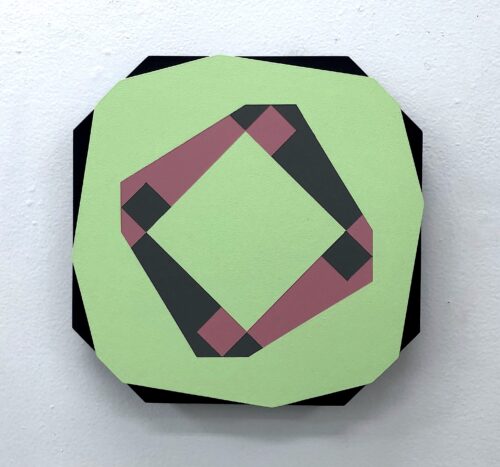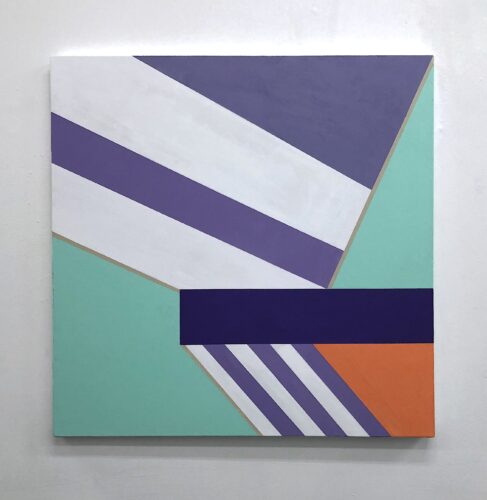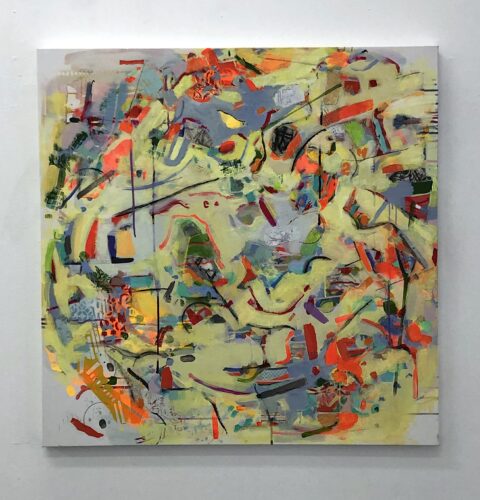Curated by Lichtundfire director Priska Juschka (the concept was originated by gallery artist Augustus Goertz), “Covert-19: Part 2, Parabole of Unity” presents six artists who have made work during the quarantine. The artists included in the show are as follows: Jane Fire, Mark Kurdziel, Eveline Luppi, Robert Solomon, Alan Steele, and Gina Werfel. Juschka is gifted in curating shows of abstract painting, usually with a muted palette, but this particular exhibition is devoted to art made with a lighter range of color. Despite the fraught circumstances surrounding the works we see, there is not much difference in the experience of the art, when it is compared to work made before the onset of the virus. It is fair to say, then, that the artists’ production was not affected to a great extent by the quarantine, although exceptions in the group do occur.
Jane Fire’s Chromaprint on aluminum, titled Real Sci Fi (2020), shows the virus on its edge, arranged in rows across the very dark background. The edges of the viruses is a radioactive orange; their tops are dark, the same color as the space around them. As the title of the image tells us, this is reality that is also beyond belief. If we think about the damage that has been done by the virus, it is hard not to see Fire’s artwork as the condemnation of a piece of malicious nature. Mark Kurdziel’s Untitled (2020), soft, luminous abstraction of variously hued geometric shapes occurs on a small linen surface. On the left is a light mauve stripe, a bright center of green, and underneath a brown and a green rectangle, each with a window in them. The atmosphere resembles the atmosphere found in works by Paul Klee, but in Kurdziel’s work there is the pathos of knowing the painting was made in isolation.
Painter Eveline Luppi is presenting a hard-edge geometric work, PT White Orange (2020) in which a right-angled design, made of a purple color and white stripes and coming into the center of the composition at a diagonal from the upper left, meets a dark purple stripe edging horizontally across the painting. It is supported by purple and white diagonal lines and an expanse of orange, close to a triangle in shape, on the right. The bottom left and upper right spaces are painted a sea green. Bush 1 Gold (2020), by Robert Solomon, examples his well-handled, mostly abstract lyricism. The work is imagistically complex; a dark brown pole runs through the middle of the painting, against a light gold tan background and a bit of bright blue at the top. In the middle of the composition, we see passages of transparent gray, offset by striped ovals and spheres–one black, two gray, and two white. This is a highly abstract composition, of the form of a bush (as indicated by the title), and Solomon’s treatment revolves around his excellent handling of form and color.
The abstract work by Alan Steele, Untitled (Fragment) (2020), consists of two shaped and painted panels, two irregular polygons, rather like a more than usually complex pentagon. The top panel, a light green polygonal expanse of paint, is centered by a painted frame of dark red and near black, exposing a diamond shape in the middle. It rests on the lower, entirely black panel, an irregular octagon with protruding edges. It is a particularly good work of art, devoted as it is to the purely technical problems of color and form, without regard to figurative imagery.
Gina Werfel’s abstraction, consisting of patches of paint backed usually by a light ground, is available in the painting Dragon (2020), a composition with a pale green-yellow foundation made complex with many differing kinds of strokes, including orange and deep yellow, slate gray and green. These bits of color enliven the painting’s presence, given as it is to an anarchic freedom of forms. Clearly, the work reflects the history of abstract expressionism, but there is something new here, too.
Juschka has made a specialty of presenting shows of quiet color, often of a dark palette. But in this show, the feeling is brighter, lighter in its hue. Who knows why this is so–it may be the result of staying indoors for a long time in response to the viral epidemic. Whatever the reasons, the show stands out as an offering of contemporary painting, in which formal considerations are matched, either overtly or by implication, with a sense of urgency in regard to the present conditions created by the quarantine. Still, with the exception of Jane Fire’s two works, there is no overt recognition of the virus. This may mean that the artists, indeed artists in general working at this time, are more interested in plying their trade than in reacting to circumstances that affect their lives but do not effectively contribute to their search for form and color. In the long run, usually external circumstances don’t have much effect on abstract art, which is primarily about itself. Juschka is to be recognized for her astute curating in this show, which keeps art alive in a time of genuine distress.
Jonathan Goodman


